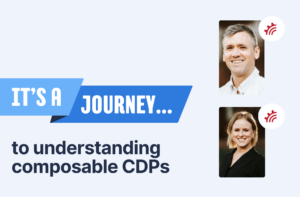As the third-party cookie is phased out by Google over the course of this year, brands are looking for every new way they can find to gather data on their customers. First-party data — data that your brand directly gathers on your customers — has long been the gold standard, but there’s another level to this sort of data that can potentially make it even more valuable.
Zero-party data is information your customers freely give you about themselves. While first-party data can include information you procured without your customers’ knowledge or direct consent, zero-party data is purposefully given to you by the customer themselves, making it incredibly useful when it comes to personalization.
Some of the ways you might gather zero-party data include:
- Form fills
- Preference updates
- Quizzes
- Surveys
- Purchase intentions
When a customer engages in these ways, they’re aware they’re giving you information about themselves and voluntarily doing so. How can brands use this sort of data to personalize better and enhance the customer experience with their messaging campaigns? Here are a few ideas that a marketer can accomplish using MessageGears:
Recommend products you know they like
It’s one thing to use first-party data to make better product recommendations. If you know someone purchased skis last week, recommending a down coat, ski boots, or a set of goggles might make sense now. But you’re making a lot of inferences there, first that they bought the skis for themselves, and secondly that they don’t already have most of the other equipment. Maybe the customer bought the skis as a gift, and they actually hate the cold. And maybe they’re a veteran skier who already has everything they need.
But what if you sent out a survey to customers asking them what sorts of products they were most interested in buying for themselves? Then, if the customer said they were eyeing all that ski equipment, you’d know that these recommendations would be well received. Not only does the customer feel like the messages they receive are more relevant, but you have a great chance of being able to get the conversion you’re looking for. It’s a win-win for the customer and the brand.
Let them hear from their local store
It’s not uncommon for brands to add some sort of local personalization to their emails, highlighting the brick-and-mortar location that’s closest to the customer’s address to remind them of where it is, what its hours are, etc. Plus, if the brand is more sophisticated, they might even be able to specify the customer’s favorite location based upon their buying activity, which is far more reliable.
But what if the location they care about the most isn’t the closest to them? It’s actually the one a mile from their daughter’s house across town, and they go whenever they visit. And maybe their daughter treats them when they go there, so buying history wouldn’t pick it up either.
If you sent out a form that included a line about their favorite store with a pulldown menu where they could choose the one that was their favorite, that sort of zero-party data would tell you directly what their preference was. Then, you could send them personalized information about that particular location, from events to store-specific sales and whatever ties back to that specific place. You’ve been able to connect with the customer in a new way.
Make their day special
Holidays can be pretty easy to create messaging campaigns around. Independence Day, Memorial Day, New Year’s Day, Halloween, and many others are shared cultural experiences, and it’s simple to have a sale or just send out messaging based around that without having to dig much into your data.
But what if you asked questions that could help you gather great information about the customer?
- Ask them for their birth date
- If a customer makes a dinner reservation, ask if they’re celebrating a particular occasion that night
- If a customer is renting a tuxedo from you, find out what event they’re attending, and when it’s happening
These are glimpses into someone’s personal life, a chance to be let in to their world a little bit. And this can be very valuable information to have.
Once you have it, now is your chance to make that day special in your own way, whether that’s offering them a unique coupon code, setting up flowers at their table, creating a personalized video congratulating them, or just a quick note to wish them a great day, this can be an opportunity to connect with them when it matters to them most.
Takeaways
Especially as third-party cookies fade away, brands need to take advantage of the opportunities they have to learn about their customers in order to engage with them in a relevant and meaningful way. Zero-party data is going to continue to gain importance in the coming years, helping brands to deliver better, more personalized experiences to their customers and generating long-term loyalty in the process.






